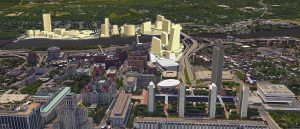News
October 19, 2017CEG Submits Proposal for Amazon to Thrive in Tech Valley
 The Center for Economic Growth (CEG) today submitted to Amazon a proposal detailing development options situated in the heart of Tech Valley for its planned $5 billion second headquarters (HQ2). In response to Amazon’s RFP, CEG identified sites that satisfy Amazon’s H2Q requirements of an initial 500,000 square feet of building space by 2019 and 8 million square feet beyond 2027.
The Center for Economic Growth (CEG) today submitted to Amazon a proposal detailing development options situated in the heart of Tech Valley for its planned $5 billion second headquarters (HQ2). In response to Amazon’s RFP, CEG identified sites that satisfy Amazon’s H2Q requirements of an initial 500,000 square feet of building space by 2019 and 8 million square feet beyond 2027.
With Amazon specifying an interest in a downtown or urban location with a layout similar to its Seattle campus, CEG’s centerpiece proposal is the Amazon Promenade. This downtown headquarters would straddle the iconic Hudson River, with a capacity for 2 million square feet of office space in the City of Albany’s 25-acre site between the Times Union Center and Broadway, and an additional capacity for 6 million square feet on 75 acres directly across the Hudson in the City of Rensselaer. The Albany and Rensselaer sites could be connected with a pedestrian bridge across the Hudson, water taxies and/or a gondola.
Click here for a video flyover rendering of the Amazon Promenade.
“Amazon encourages its leaders to ‘think big,’ and here in New York’s Capital Region – the heart of Tech Valley – we’ve consistently put that principle to practice. Thinking big is in our blood and in our history, starting with Thomas Edison in Schenectady,” said Laura Schweitzer, chair of the CEG Board of Directors and the University of Albany’s vice president for health sciences. “Thinking big was what compelled us to build a world-class R&D infrastructure and what enabled us to attract the largest chip fab in North America, and it is in that spirit that we are pursuing HQ2. From our revitalized downtowns to our anchor educational institutions that train and educate our robust talent pipeline, we’ve already laid the foundation. Our plan for a trans-Hudson Amazon headquarters is just another example of how we in Tech Valley think big. Years ago CEG played a critical role in laying the groundwork for the GLOBALFOUNDRIES chip plant, and it’s good to see the organization continue its tradition of thinking big with the Amazon bid.”
“Tech Valley has the talent, technical capabilities and research assets that Amazon and all tech companies need to thrive and grow. The Center for Economic Growth has identified sites where the company can fit into a vibrant downtown that reflects Amazon’s culture, while offering Amazon and other companies unique attributes of a high quality of life and a low cost of living,” said James J. Barba, president and CEO, Albany Medical Center.
With Amazon also expressing an interest in 100-acres greenfield sites and suburban locations, CEG’s proposal identified alternative sites in Albany and Saratoga counties.
Region-wide Effort
CEG prepared the HQ2 proposal in collaboration with Capitalize Albany, Rensselaer County IDA, Saratoga County Prosperity Partnership and Saratoga Economic Development Corp. New York State submitted an aggressive incentive package to Amazon on behalf of Tech Valley.
To strengthen CEG’s bid, our regional partners have made the following pledges:
- Establish unique transportation options including improved public transportation and direct flights to Seattle.
- Develop curriculum in Amazon’s target fields of computer science and business with the region’s anchor higher education institutions.
- Provide R&D assistance in areas of strategic importance to Amazon.
- Create a new platform to access Tech Valley’s IT infrastructure to develop high-tech, data-driven models that promote innovation and growth.
- Provide resources to support economic and workforce development efforts.
“Tech Valley’s vast network of colleges and universities can provide the diverse talent pool Amazon seeks for HQ2,” said University at Albany President Havidán Rodríguez. “UAlbany supplies graduates to major employers throughout the region with specialized training in data analytics, computer engineering, digital forensics, and behavioral cybersecurity, among other relevant fields. And in collaboration with our partners in higher education, we are ready to work with Amazon to create programs targeted to its workforce needs.”
“For nearly 200 years, Rensselaer has supported industry partnerships and the transfer of technology from the laboratory to the marketplace so that new discoveries and inventions benefit society and strengthen economic development. There has been a profound and positive impact in Tech Valley and the higher education sector is an important driver of the Capital Region’s economy,” said Rensselaer Polytechnic Institute (RPI) President, Dr. Shirley Ann Jackson. “Rensselaer is committed to partnering with the Center for Economic Growth to demonstrate that Tech Valley has a world-class talent pool, research capacity in high performance computing, data analytics, cognitive computing, advanced manufacturing and industrial automation, and successful record of partnering with Fortune 100 global businesses.”
How Tech Valley Competes
In Tech Valley, Amazon will find a region that is economically more stable than the Seattle-Tacoma-Bellevue metropolitan statistical area (MSA) and equipped with four times more academic computer and information sciences R&D space. Tech Valley also has a talent pipeline that awards more business degrees and more intensely generates computer degrees. Even more, compared to the Seattle-Tacoma-Bellevue MSA, Tech Valley has a housing market that is 45 percent more affordable, has less crime and is significantly less at risk to natural disasters.
“An Albany location for Amazon HQ2 is a win-win for Amazon, the State of New York, and the thousands of stakeholders that will benefit from this unprecedented economic development” said Capitalize Albany chair, Michael J. Castellana. “The region, a historic pioneer in commerce, will partner with Amazon in the re-creation of commerce for the 21st century as we combine our beautiful natural resources, unparalleled location with access to 40 percent of North America’s population, and a willingness to transform the region into Amazon Northeast.”
A project the scale of HQ2, which promises to employ up to 50,000 full-time employees, will pull talent from a geographic area that reaches beyond the New York State-defined, eight-county Capital Region. The Capital Region is 18 percent smaller than the 6,310-square-mile Seattle-Tacoma-Bellevue MSA. However, CEG anticipates HQ2 would also attract workers from within the eight counties as well as seven surrounding counties within a 60- to 90-minute commute of Albany. This 15-county Tech Valley region has a population of 1,860,410 and a labor force of 920,393. That labor force is highly educated, with nearly a third of the region’s adults 25 years and older (31.4 percent) holding a bachelor’s degree or higher.
Tech Valley has 31 colleges and universities with degrees in Amazon-relevant fields, compared to 36 in the Seattle-Tacoma-Bellevue MSA. In 2016, Tech Valley had 20,803 computer-related jobs, and for every 1,000 jobs the region on average awarded 54 computer-related degrees. That was three times greater than the Seattle-Tacoma-Bellevue MSA’s rate of 16 computer-related degrees per 1,000 relevant jobs. Seventy percent of the 3,369 computer degrees awarded in Tech Valley over the past three years were in computer science, computer and information science, computer engineering technologies and human-computer interaction, which commonly involve training in software development – a key skill identified by Amazon in the RFP.
On top of stressing talent attraction and retention, Amazon’s RFP places a premium on “a stable business climate for growth and innovation” and a “high quality of life.” Here is how Tech Valley compares to the Seattle-Tacoma-Bellevue MSA in those areas:
Stability
Tech Valley offers Amazon an environment that provides far more stability than what it currently has in the Seattle-Tacoma-Bellevue MSA. During the past two decades, Tech Valley’s unemployment rate has consistently come in below the nation’s, whereas the Seattle-Tacoma-Bellevue MSA’s rate was lower in only 14 of the last 20 years. Even more, Tech Valley’s unemployment rate came in below the Seattle-Tacoma-Bellevue MSA’s rate for 12 of the last 20 years.
Amazon will also find less natural disaster risk in Tech Valley than in the Seattle-Tacoma-Bellevue MSA. According to a CEG analysis of RealtyTrac’s 2015 Natural Disaster Housing Risk Report, Tech Valley has an average natural disaster score of 33 (medium risk of natural disaster), whereas the Seattle-Tacoma-Bellevue MSA’s average score is 58 (high risk). The natural disaster risk score weighs each county’s risk of earthquake, hurricane, tornado, flood and wildfire.
R&D
Tech Valley has the R&D assets that can arm Amazon with a cutting edge advantage in machine learning, cloud and cognitive computing and cybersecurity. The region houses 64,200 square feet of university computer and information science R&D space, compared to approximately 14,000 square feet in the Seattle-Tacoma-Bellevue MSA. Tech Valley’s math and computer science R&D spending also rivals that of the Seattle-Tacoma-Bellevue MSA, $22.5 million to $25.3 million, according to a CEG analysis of data from the National Center for Science and Engineering Statistics.
Much of Tech Valley’s R&D space is found at RPI’s Center for Computational Information (CCI), which houses the most powerful university-based supercomputer in New York State and the Northeast. CCI operates heterogeneous supercomputing systems consisting of massively parallel IBM Blue Gene/Q supercomputer and Intel Xeon processor-based clusters. The computational power of the current hardware configuration is rated at over 1 PF peak. Marist College’s Enterprise Computing Research Laboratory also houses a zEnterprise processor with zBladeCenter extension, an IBM PureFlex System and a Netezza data warehouse appliance.
Quality of Life
Seattle has clearly provided Amazon with a quality of life where its employees can thrive, but Tech Valley can offer them more. Affordability is one of the region’s key advantages, with the Albany-Schenectady-Troy MSA’s Affordability Index of Existing Single-Family Homes registering at 227, compared to 124 for the Seattle-Tacoma-Bellevue MSA. (100 = median income equivalent to minimum income required for mortgage on a median-priced home). At 99.7, the Albany-Schenectady-Troy MSA cost of living, as measured by the U.S. Bureau of Economic Analysis’ Regional Price Parity index is below the national average (100), whereas the Seattle-Tacoma-Bellevue MSA’s is above it at 109.4.
Tech Valley’s violent crime rate per 100,000 people is significantly lower than the Seattle-Tacoma-Bellevue MSA’s (222:353), as is its property crime rate (1,552:3,890). Tech Valley also dominates when it comes to leisure and recreation, surrounded by the Catskills, Berkshires and Adirondacks and filled with arts, cultural and food destinations in between them. For example, compared to the Seattle-Tacoma-Bellevue MSA, Tech Valley has more state parks (25:22), more museums (73:46), full-service restaurants per capita (10:9), amusement parks (10:6) and national historic sites and parks (6:2). The average travel time to work in Tech Valley is comparable to that of the Seattle-Tacoma-Bellevue MSA (29.7 minutes:29 minutes), though it is shorter in the Capital Region (23.1 minutes).
“An HQ2 on the Rensselaer waterfront and across the river in downtown Albany would enable Amazon to meld with vibrant urban downtowns that are primed for an influx of tech savvy workers hungry for live-work-play options. This area has real soul, and that is something you just cannot build. It’s what made Seattle such a fertile ground for Amazon and what we’ve been nurturing for decades. Yes, we’ve revitalized this area with waterfront parks and other amenities, but the soul was always there and it’s been getting stronger,” said Rensselaer County IDA Executive Director Robert Pasinella.
“We were asked in the RFP to ‘think big and creative,’ and the Amazon Promenade is the epitome of that,” said CEG President and CEO Andrew Kennedy. “Here Amazon has an opportunity to establish a waterfront headquarters along the river that turned America into an international commercial power and in a thriving downtown that offers the live-work-play options that its talented workforce loves in Seattle. Only here you don’t have the gridlock and burdensome cost of living. The bottom line is Tech Valley is where innovation takes root; it’s where Amazon can thrive.”


























